[English] 日本語
 Yorodumi
Yorodumi- PDB-5ohp: Crystal structure of USP30 (C77A) in complex with Lys6-linked diu... -
+ Open data
Open data
- Basic information
Basic information
| Entry | Database: PDB / ID: 5ohp | ||||||
|---|---|---|---|---|---|---|---|
| Title | Crystal structure of USP30 (C77A) in complex with Lys6-linked diubiquitin | ||||||
 Components Components |
| ||||||
 Keywords Keywords | HYDROLASE / DUB / Ubiquitin / USP / K6 | ||||||
| Function / homology |  Function and homology information Function and homology informationprotein K6-linked deubiquitination / protein K11-linked deubiquitination / deubiquitinase activity / autophagy of mitochondrion / pexophagy / hypothalamus gonadotrophin-releasing hormone neuron development / female meiosis I / peroxisomal membrane / mitochondrial fusion / positive regulation of protein monoubiquitination ...protein K6-linked deubiquitination / protein K11-linked deubiquitination / deubiquitinase activity / autophagy of mitochondrion / pexophagy / hypothalamus gonadotrophin-releasing hormone neuron development / female meiosis I / peroxisomal membrane / mitochondrial fusion / positive regulation of protein monoubiquitination / fat pad development / mitochondrion transport along microtubule / female gonad development / seminiferous tubule development / negative regulation of mitophagy / male meiosis I / positive regulation of intrinsic apoptotic signaling pathway by p53 class mediator / protein deubiquitination / energy homeostasis / regulation of neuron apoptotic process / neuron projection morphogenesis / regulation of proteasomal protein catabolic process / Maturation of protein E / Maturation of protein E / ER Quality Control Compartment (ERQC) / Myoclonic epilepsy of Lafora / FLT3 signaling by CBL mutants / Constitutive Signaling by NOTCH1 HD Domain Mutants / IRAK2 mediated activation of TAK1 complex / Prevention of phagosomal-lysosomal fusion / Alpha-protein kinase 1 signaling pathway / Glycogen synthesis / IRAK1 recruits IKK complex / IRAK1 recruits IKK complex upon TLR7/8 or 9 stimulation / Endosomal Sorting Complex Required For Transport (ESCRT) / Membrane binding and targetting of GAG proteins / Negative regulation of FLT3 / Regulation of TBK1, IKKε (IKBKE)-mediated activation of IRF3, IRF7 / PTK6 Regulates RTKs and Their Effectors AKT1 and DOK1 / Regulation of TBK1, IKKε-mediated activation of IRF3, IRF7 upon TLR3 ligation / IRAK2 mediated activation of TAK1 complex upon TLR7/8 or 9 stimulation / NOTCH2 Activation and Transmission of Signal to the Nucleus / TICAM1,TRAF6-dependent induction of TAK1 complex / TICAM1-dependent activation of IRF3/IRF7 / APC/C:Cdc20 mediated degradation of Cyclin B / Downregulation of ERBB4 signaling / Regulation of FZD by ubiquitination / APC-Cdc20 mediated degradation of Nek2A / p75NTR recruits signalling complexes / InlA-mediated entry of Listeria monocytogenes into host cells / TRAF6 mediated IRF7 activation in TLR7/8 or 9 signaling / TRAF6-mediated induction of TAK1 complex within TLR4 complex / Regulation of pyruvate metabolism / NF-kB is activated and signals survival / Regulation of innate immune responses to cytosolic DNA / Pexophagy / Downregulation of ERBB2:ERBB3 signaling / NRIF signals cell death from the nucleus / Regulation of PTEN localization / Activated NOTCH1 Transmits Signal to the Nucleus / VLDLR internalisation and degradation / Regulation of BACH1 activity / Synthesis of active ubiquitin: roles of E1 and E2 enzymes / MAP3K8 (TPL2)-dependent MAPK1/3 activation / Translesion synthesis by REV1 / TICAM1, RIP1-mediated IKK complex recruitment / Translesion synthesis by POLK / InlB-mediated entry of Listeria monocytogenes into host cell / positive regulation of protein ubiquitination / Activation of IRF3, IRF7 mediated by TBK1, IKKε (IKBKE) / JNK (c-Jun kinases) phosphorylation and activation mediated by activated human TAK1 / Josephin domain DUBs / Downregulation of TGF-beta receptor signaling / Translesion synthesis by POLI / IKK complex recruitment mediated by RIP1 / Gap-filling DNA repair synthesis and ligation in GG-NER / Regulation of activated PAK-2p34 by proteasome mediated degradation / PINK1-PRKN Mediated Mitophagy / TGF-beta receptor signaling in EMT (epithelial to mesenchymal transition) / regulation of mitochondrial membrane potential / TNFR1-induced NF-kappa-B signaling pathway / Autodegradation of Cdh1 by Cdh1:APC/C / TCF dependent signaling in response to WNT / APC/C:Cdc20 mediated degradation of Securin / Regulation of NF-kappa B signaling / N-glycan trimming in the ER and Calnexin/Calreticulin cycle / activated TAK1 mediates p38 MAPK activation / Asymmetric localization of PCP proteins / SCF-beta-TrCP mediated degradation of Emi1 / NIK-->noncanonical NF-kB signaling / Ubiquitin-dependent degradation of Cyclin D / TNFR2 non-canonical NF-kB pathway / Regulation of signaling by CBL / AUF1 (hnRNP D0) binds and destabilizes mRNA / Negative regulators of DDX58/IFIH1 signaling / NOTCH3 Activation and Transmission of Signal to the Nucleus / Vpu mediated degradation of CD4 / Assembly of the pre-replicative complex / Ubiquitin-Mediated Degradation of Phosphorylated Cdc25A / Deactivation of the beta-catenin transactivating complex Similarity search - Function | ||||||
| Biological species |  Homo sapiens (human) Homo sapiens (human) | ||||||
| Method |  X-RAY DIFFRACTION / X-RAY DIFFRACTION /  SYNCHROTRON / SYNCHROTRON /  MOLECULAR REPLACEMENT / Resolution: 2.8 Å MOLECULAR REPLACEMENT / Resolution: 2.8 Å | ||||||
 Authors Authors | Gersch, M. / Komander, D. | ||||||
| Funding support |  United Kingdom, 1items United Kingdom, 1items
| ||||||
 Citation Citation |  Journal: Nat. Struct. Mol. Biol. / Year: 2017 Journal: Nat. Struct. Mol. Biol. / Year: 2017Title: Mechanism and regulation of the Lys6-selective deubiquitinase USP30. Authors: Gersch, M. / Gladkova, C. / Schubert, A.F. / Michel, M.A. / Maslen, S. / Komander, D. | ||||||
| History |
|
- Structure visualization
Structure visualization
| Structure viewer | Molecule:  Molmil Molmil Jmol/JSmol Jmol/JSmol |
|---|
- Downloads & links
Downloads & links
- Download
Download
| PDBx/mmCIF format |  5ohp.cif.gz 5ohp.cif.gz | 108.1 KB | Display |  PDBx/mmCIF format PDBx/mmCIF format |
|---|---|---|---|---|
| PDB format |  pdb5ohp.ent.gz pdb5ohp.ent.gz | 81.4 KB | Display |  PDB format PDB format |
| PDBx/mmJSON format |  5ohp.json.gz 5ohp.json.gz | Tree view |  PDBx/mmJSON format PDBx/mmJSON format | |
| Others |  Other downloads Other downloads |
-Validation report
| Summary document |  5ohp_validation.pdf.gz 5ohp_validation.pdf.gz | 767.1 KB | Display |  wwPDB validaton report wwPDB validaton report |
|---|---|---|---|---|
| Full document |  5ohp_full_validation.pdf.gz 5ohp_full_validation.pdf.gz | 770.2 KB | Display | |
| Data in XML |  5ohp_validation.xml.gz 5ohp_validation.xml.gz | 18 KB | Display | |
| Data in CIF |  5ohp_validation.cif.gz 5ohp_validation.cif.gz | 24.6 KB | Display | |
| Arichive directory |  https://data.pdbj.org/pub/pdb/validation_reports/oh/5ohp https://data.pdbj.org/pub/pdb/validation_reports/oh/5ohp ftp://data.pdbj.org/pub/pdb/validation_reports/oh/5ohp ftp://data.pdbj.org/pub/pdb/validation_reports/oh/5ohp | HTTPS FTP |
-Related structure data
| Related structure data | 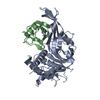 5ohkSC  5ohnC S: Starting model for refinement C: citing same article ( |
|---|---|
| Similar structure data |
- Links
Links
- Assembly
Assembly
| Deposited unit | 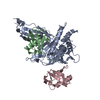
| |||||||||||||||
|---|---|---|---|---|---|---|---|---|---|---|---|---|---|---|---|---|
| 1 |
| |||||||||||||||
| Unit cell |
| |||||||||||||||
| Components on special symmetry positions |
|
- Components
Components
| #1: Protein | Mass: 38437.355 Da / Num. of mol.: 1 Fragment: UNP residues 64-178,UNP residues 217-357,UNP residues 432-502 Mutation: construct 13i (C77A, R179G, Q180S, P181G, R182S, F348D, M350S, I353E, L358S, L359N, G360A) Source method: isolated from a genetically manipulated source Source: (gene. exp.)  Homo sapiens (human) / Gene: USP30 / Plasmid: MG-31-28 / Production host: Homo sapiens (human) / Gene: USP30 / Plasmid: MG-31-28 / Production host:  | ||||
|---|---|---|---|---|---|
| #2: Protein | Mass: 8576.831 Da / Num. of mol.: 2 Source method: isolated from a genetically manipulated source Source: (gene. exp.)  Homo sapiens (human) / Gene: UBB / Production host: Homo sapiens (human) / Gene: UBB / Production host:  #3: Chemical | ChemComp-ZN / | #4: Water | ChemComp-HOH / | |
-Experimental details
-Experiment
| Experiment | Method:  X-RAY DIFFRACTION / Number of used crystals: 1 X-RAY DIFFRACTION / Number of used crystals: 1 |
|---|
- Sample preparation
Sample preparation
| Crystal | Density Matthews: 2.49 Å3/Da / Density % sol: 50.68 % |
|---|---|
| Crystal grow | Temperature: 291 K / Method: vapor diffusion, sitting drop / pH: 7 / Details: 0.73 M sodium citrate, 0.1 M Hepes pH 7.0 |
-Data collection
| Diffraction | Mean temperature: 100 K |
|---|---|
| Diffraction source | Source:  SYNCHROTRON / Site: SYNCHROTRON / Site:  Diamond Diamond  / Beamline: I24 / Wavelength: 0.9686 Å / Beamline: I24 / Wavelength: 0.9686 Å |
| Detector | Type: DECTRIS PILATUS3 6M / Detector: PIXEL / Date: Oct 2, 2016 |
| Radiation | Protocol: SINGLE WAVELENGTH / Monochromatic (M) / Laue (L): M / Scattering type: x-ray |
| Radiation wavelength | Wavelength: 0.9686 Å / Relative weight: 1 |
| Reflection | Resolution: 2.8→82.08 Å / Num. obs: 14395 / % possible obs: 99.18 % / Redundancy: 4.7 % / Biso Wilson estimate: 39.7 Å2 / CC1/2: 0.99 / Rmerge(I) obs: 0.1702 / Rpim(I) all: 0.0863 / Net I/σ(I): 6.99 |
| Reflection shell | Resolution: 2.8→2.9 Å / Redundancy: 4.8 % / Rmerge(I) obs: 0.9977 / Mean I/σ(I) obs: 1.83 / Num. unique obs: 1402 / CC1/2: 0.713 / Rpim(I) all: 0.5044 / % possible all: 99.86 |
- Processing
Processing
| Software |
| ||||||||||||||||||||||||||||||||||||||||||
|---|---|---|---|---|---|---|---|---|---|---|---|---|---|---|---|---|---|---|---|---|---|---|---|---|---|---|---|---|---|---|---|---|---|---|---|---|---|---|---|---|---|---|---|
| Refinement | Method to determine structure:  MOLECULAR REPLACEMENT MOLECULAR REPLACEMENTStarting model: 5OHK Resolution: 2.8→82.077 Å / SU ML: 0.34 / Cross valid method: FREE R-VALUE / σ(F): 1.33 / Phase error: 26.88
| ||||||||||||||||||||||||||||||||||||||||||
| Solvent computation | Shrinkage radii: 0.9 Å / VDW probe radii: 1.11 Å | ||||||||||||||||||||||||||||||||||||||||||
| Refinement step | Cycle: LAST / Resolution: 2.8→82.077 Å
| ||||||||||||||||||||||||||||||||||||||||||
| Refine LS restraints |
| ||||||||||||||||||||||||||||||||||||||||||
| LS refinement shell |
|
 Movie
Movie Controller
Controller


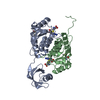


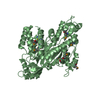
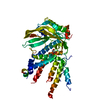
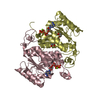


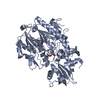
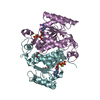
 PDBj
PDBj



















